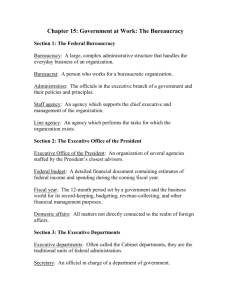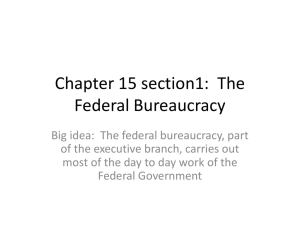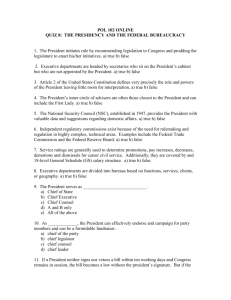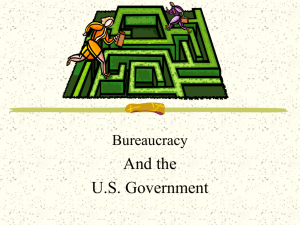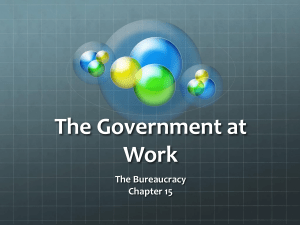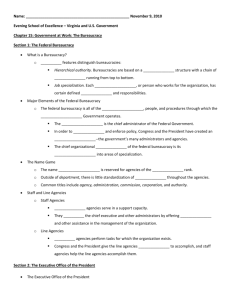Federal bureaucracy
advertisement
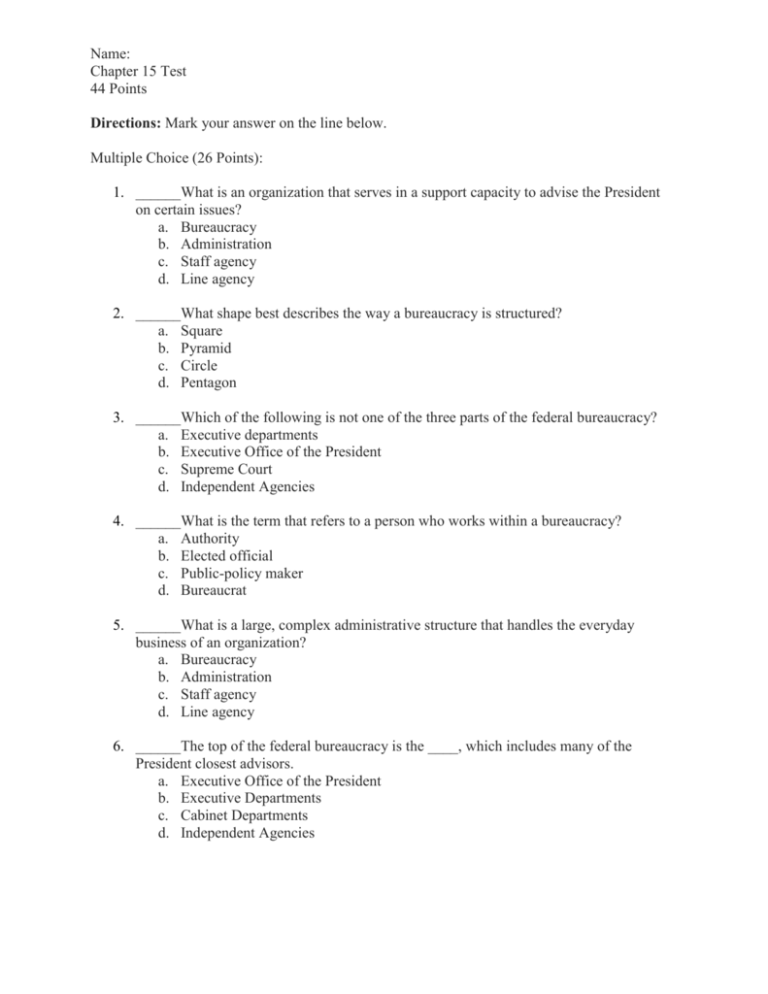
Name: Chapter 15 Test 44 Points Directions: Mark your answer on the line below. Multiple Choice (26 Points): 1. ______What is an organization that serves in a support capacity to advise the President on certain issues? a. Bureaucracy b. Administration c. Staff agency d. Line agency 2. ______What shape best describes the way a bureaucracy is structured? a. Square b. Pyramid c. Circle d. Pentagon 3. ______Which of the following is not one of the three parts of the federal bureaucracy? a. Executive departments b. Executive Office of the President c. Supreme Court d. Independent Agencies 4. ______What is the term that refers to a person who works within a bureaucracy? a. Authority b. Elected official c. Public-policy maker d. Bureaucrat 5. ______What is a large, complex administrative structure that handles the everyday business of an organization? a. Bureaucracy b. Administration c. Staff agency d. Line agency 6. ______The top of the federal bureaucracy is the ____, which includes many of the President closest advisors. a. Executive Office of the President b. Executive Departments c. Cabinet Departments d. Independent Agencies 7. ______Who directs all of the operations of the White House Office? a. The deputy assistant to the President b. The chief of staff to the President c. The press secretary d. The counsel to the President 8. ______All of the following are members of the National Security Council EXCEPT: a. Secretary of State b. Secretary of Defense c. Joint Chiefs of Staff d. Director of the CIA 9. ______How many agencies/offices exist in today’s Executive Office of the President? a. 10 b. 12 c. 15 d. 8 10. ______The Office of Management and Budget have all of the following tasks EXCEPT: a. Preparing the federal budget which the President will send to Congress b. Keeping the President up to date on the work of all agencies c. Reviewing and revising executive orders d. Advising the President on matters of the nation’s economy 11. ______Which office located in the Executive Office of the President is responsible for advising the President on matters related to the nation’s security? a. Office of Management and Budget b. Department of Defense c. National Security Council d. White House Office 12. ______How many members serve of the Council of Economic Advisors? a. Three b. Four c. Seven d. Ten 13. ______The Cabinet departments are also known as a. Administrative departments b. Executive departments c. Presidential departments d. Secretarial departments 14. ______How many Cabinet departments exist today? a. 12 b. 14 c. 15 d. 10 15. ______All but one Cabinet department is headed by: a. Secretaries b. Advisors c. Executives d. Attorney Generals 16. ______Which of the following Cabinet departments is NOT one of the original four? a. Department of Defense b. Department of State c. Department of Commerce d. Department of the Treasury 17. ______Who creates new Cabinet departments whenever necessary? a. Congress b. Senate c. House of Representatives d. President 18. ______Which Cabinet department is the largest? a. Defense b. State c. Justice d. Homeland Security 19. ______The newest Cabinet department is the ____. a. Department of Defense b. Department of Veterans Affairs c. Department of Education d. Department of Homeland Security 20. ______The Attorney General heads which department? a. Department of Justice b. Department of State c. Department of the Treasury d. Department of Homeland Security 21. ______Which of the following is not one of the three types of independent agencies? a. Independent Executive Agencies b. Independent Regulatory Commissions c. Government Corporations d. Executive Departments 22. ______How many independent regulatory commissions do we have today? a. 10 b. 15 c. 150 d. 50 23. ______Which of the following has a board or commission of five to seven members? a. Independent Executive Agencies b. Government Corporations c. Independent Regulatory Commissions d. Executive Departments 24. ______ ___ are similar to Cabinet departments in the sense that they are headed by a single administrator in charge of the agency. a. Independent Executive Agencies b. Government Corporations c. Independent Regulatory Commissions d. Executive Departments 25. ______Rules and regulations passed by this type of independent agency have the force of law: a. Independent Executive Agencies b. Government Corporations c. Independent Regulatory Commissions d. Executive Departments 26. ______In which of the following ways are government corporations similar to private corporations? a. Congress appropriates the funds for each b. Each can decide their purpose and what functions to perform c. Both are run by a board of directors d. Employees of each are public employees True or False (8 Points): Write out True of False on the lines below. 27. ______Line agencies serves as an advisory group to the President and does not complete actual work designated to the agency. 28. ______Secretaries must be appointed by the President and approved by the House of Representatives. 29. ______The only job secretaries are responsible for is advising the President on matters related to their specific Cabinet department. 30. ______Independent agencies are created by the President and are located outside of Cabinet departments. 31. ______Independent agencies exist to protect them from partisan influence. 32. ______The Federal Communication System (FCC), an independent regulatory commission, is a staff agency and serves as an advisory group to the President. 33. ______Unlike private corporations, government corporations are funded by public funds. 34. ______Cabinet departments are traditional units of federal administration and each is built around a broad field. Short Answer (10 Points): You may answer the following questions below. Identify an example of a bureaucratic organization (not the government). Explain why this organization is an example using the three characteristics of a bureaucracy. Describe two pros/benefits and two con/drawbacks of bureaucracies.


